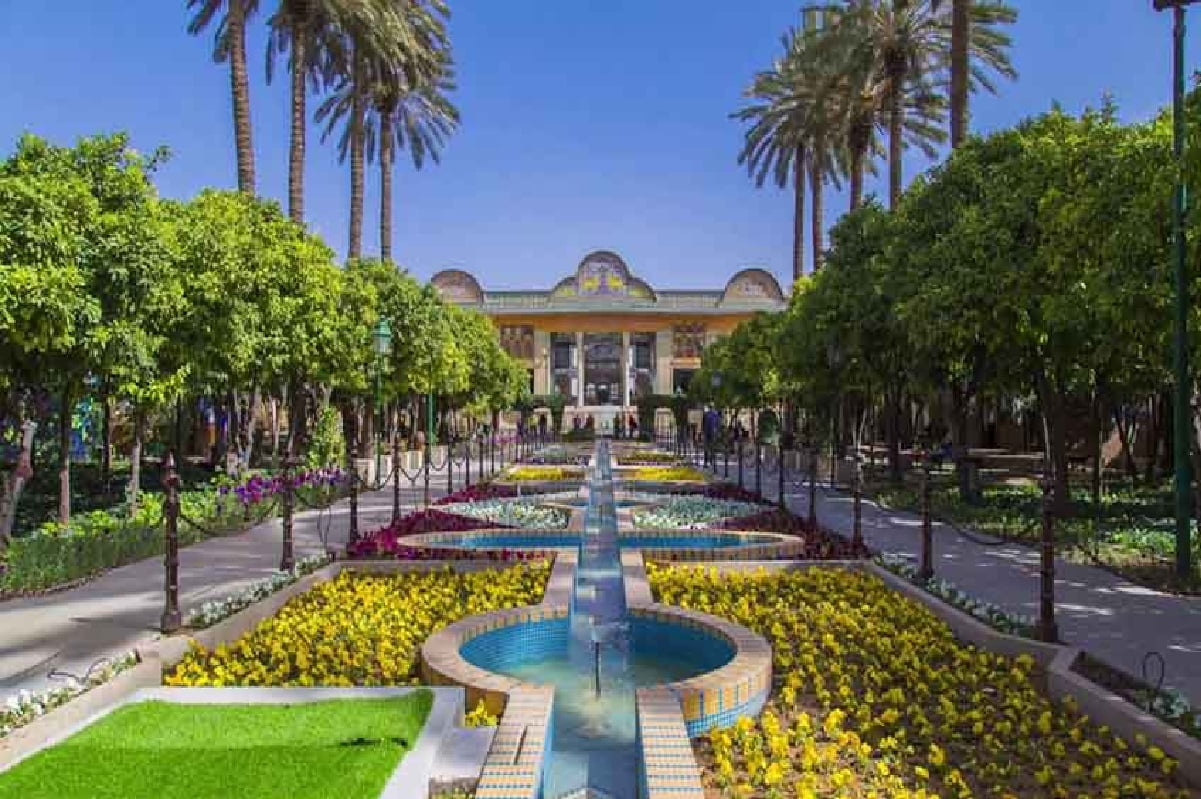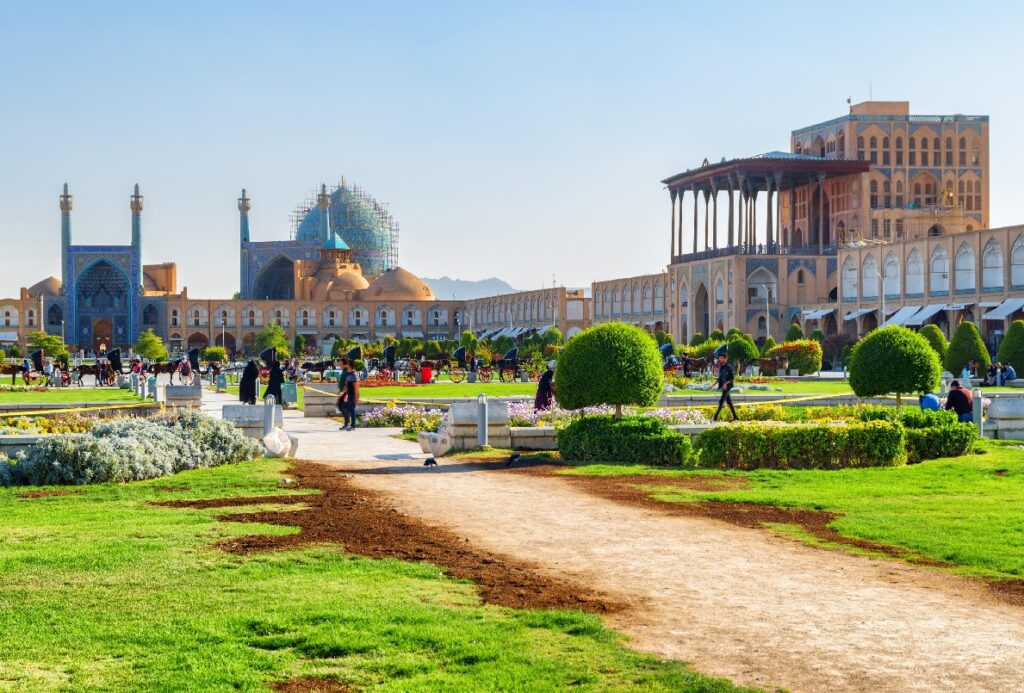Shiraz, also called the “City of Gardens,” enchants tourists with its verdant scenery and ancient beauty while providing a tranquil haven in nature’s embrace. Among its numerous gems, Delgosha Garden is a timeless masterpiece that reflects centuries of beauty and cultural value by fusing graceful architecture, old cypress trees, fragrant orange groves and serene fountains.
We are going to provide history and nature lovers with detailed information about Deglosha Garden, from its rich history to helpful tips for visitors.
A Journey Through Time: The Rich History of Delgosha Garden
First, let’s see the historical attributes of this great Persian Garden together:
Historical Roots
The history of Delgosha Garden begins with the height of Persian garden architecture, which was the Sassanid era (3rd-7th centuries CE). The Zoroastrian principles of harmony between sky, water, earth and plants were reflected in the design of these gardens, which were intended to be earthly paradises. Delgosha is a pillar of Persian horticultural history with design and water features that magnificently reflect this ancient perspective.
Revival and Excellence
The popularity and appeal of the Delgosha Garden reached its peak during the Safavid and Zand eras. The Persian garden is an icon of royal excellence, renovated by the orders of a ruler called Karim Khan Zand, who loved the city of Shiraz. Throughout the Zand period, the garden flourished, its orange blossoms and magnificent pavilion gaining popularity.
Enduring Beauty
During the Qajar and Pahlavi eras, Delgosha Garden was a popular spot that underwent intermittent restorations to preserve its historical charm and natural splendor. The garden’s tranquil atmosphere, graceful pavilions and ancient cypress-lined pathways have surprisingly endured despite Iran’s political changes and changing historical trends.
Delgosha is a living example of Shiraz’s architectural and cultural heritage because of its ageless allure, which has enthralled poets, tourists and historians alike.
The Inspiration for Timur
According to legend, the famous conqueror Timur (Tamerlane) visited the Delgosha garden in the 14th century and was so taken by its beauty and peace that he ordered a similar garden to be built in his city, Samarkand, and named it “Delogsha” as well. This timeless tale shows the garden’s significant cultural and aesthetic influence, which goes well beyond the boundaries of Persia.
A National Heritage Site
Delgosha is currently protected and considered an Iranian National Heritage Site due to its cultural and historical value. Scholars, travelers and locals who wish to learn more about Iran’s rich history are still drawn to it by its lasting legacy.

Architectural Marvels and Botanical Wonders
Now let’s head on to the architectural features of this Persian garden in Shiraz:
The Quintessential Persian Garden Design
The Persian Chahar Bagh (4 Gardens) design, which is a quadrilateral pattern representing the four elements of paradise―water, sky, earth and plants―is best represented at Delgosha Garden. The garden is divided into 4 symmetrical sections and has a serene, well-balanced appearance thanks to the water channels and crossing pathways.
Water is essential to Delgosha and is supplied by the Qanat of Sa’dieh, an ingenious underground canal that has existed for hundreds of years. Streams and fountains bring life to the landscape, and their soft and gentle sounds enhance the peaceful atmosphere. The focal feature is the central pool, which reflects the pavilion and the sky and symbolizes the Persian notion that water is a source of energy and purity.
The Grand Central mansion (Kolah Farangi Pavilion)
The Kolah Farangi Pavilion is modeled after Sassanid palace architecture, which was constructed during the Zand dynasty. Its distinctive design is reflected in its moniker, “foreign hat,” which highlights Zand-era innovation. With its elegant design that blends in with the surroundings, the 3-story pavilion provides satisfying views of the garden.
With its towering, carved columns, the ayvan blends interior and outdoor areas and offers a sheltered haven with panoramic views as it opens to the garden. The inside is decorated with vivid paintings of historical, floral motifs, mirror work and elaborate plasterwork.
The intricate woodwork ceilings show the artistry of Zand designs. Inside is a museum that offers insights into Iran’s modern history through the display of stamps, coins and vintage radios.
Aromatic Orange Groves
Delgosha is dominated by bitter orange (Narenj) trees, which define the area with their glossy foliage and colorful fruit. Orange blossoms create an emotional and fantastic vibe in April and May with their heady scent. The garden’s luscious diversity is further enhanced with flowerbeds, lawns and trees like pine, cypress and palm. Exploration is guided by planned walkways that emphasize tranquility and symmetry and are surrounded by water channels.
Planning Your Visit: When to Go to Delgosha Garden and What to Expect
Many tourists want to know the right time to visit a place in any part of the world. That’s why it’s important to know which season and at what time you should visit this beautiful Persian garden. Here are the details:
The Best Time to Visit Delgosha Garden
The best time to visit Delgosha Garden is in the spring season, when the orange trees are in full bloom and the weather is pleasant (15-25°C). This season is very charming and provides a sensory feast because of the scent of the blooms and the beautiful greenery.
Other Seasons
Summer provides lush greenery, although temperatures can rise to 30 to 35°C, so make sure to visit early. The garden is transformed with vibrant foliage in autumn, and the pavilion serves as a comfortable focal point in the peaceful winter months when temperatures range from 5 to 15°C. Every season shows a different aspect of Delgosha’s allure.
Avoiding Crowds
During the busiest travel seasons, such as spring, try to come in the early morning (8 to 10 AM) or late afternoon (4 to 6 PM) for a more relaxing experience. These periods provide a more tranquil experience, enabling you to enjoy the peace and quiet of this garden.
Opening Hours
Although hours can change depending on the season, Delgosha Garden is normally open from 8 AM to 8 PM. Before visiting this garden, be sure to see local listings or just contact us at Irun2Iran to know about the timings, because they may change.
Entrance Fee
Everybody can easily visit this beautiful Persian garden due to the fair price of its entrance fee. Although the price may be fair, we still recommend checking out the most recent pricing before visiting this garden. This is because the entrance fee may change due to local regulations or seasonal changes.
Facilities
There are basic amenities in the garden available for visitors, including restrooms. There are also great souvenir shops or cozy tea houses nearby, providing traditional handicrafts and Persian tea, which enhance the tourist experience.
Experiencing Delgosha Garden: Activities and Highlights
Tourists can engage in several amazing activities when visiting Shiraz’s Delgosha Garden. The following are a few of the highlights and activities:
Stroll and Tranquility
Walking around the garden might seem simple, but in action, it may be one of the most incredible experiences you might have while visiting the Delgosha Garden. Visitors will definitely enjoy the pleasant smell of orange flowers in bloom, as well as the soft sound of flowing fountains. These features alone will create a peaceful vibe and massage your soul, so to speak.
The garden’s arrangement is intended to promote reflection and serenity, allowing guests to walk slowly and thoughtfully while completely enjoying its tranquil ambiance and unspoiled beauty.
Visit the Museum and Mansion
The Kolah Farangi Pavilion and its museum provide a fascinating glimpse into the Zand period’s architectural and cultural legacy. Once a ceremonial palace, the octagonal structure now houses a carefully selected collection of historical artifacts.
These artifacts can include antique coins, manuscripts and radios, which offer a tangible connection to the rich past of Persia, giving visitors an engaging and instructive experience that deepens their knowledge of Persian history.
Photography Opportunities
The stunning surroundings are provided by the center pool, sophisticated pavilion and verdant orange groves, perfect for photographers. The symmetrical layout of the garden, which is mirrored in the waters, and the vivid colors of the in-season flowers combine to provide an eye-catching scene.
Delgosha Garden is a fantastic location to take outstanding photos that will be added to your album of unforgettable experiences. This is because you will love everything about it, regardless of your interest in the complexities of architecture or the splendor of nature.
Unwind by the Fountains
The Delgosha Garden’s fountains are one of the best features that tourists love. It provides a tranquil retreat from the outer world. A calm atmosphere is guaranteed by the gentle rustling leaves and aromatic flowers, as well as the calming sound of flowing water, rejuvenating one’s soul. It is the best location to just stop, take a deep breath and meditate so visitors may really enjoy the heavenly vibe of Delgosha Garden.
Inhale the Scent of Orange Blossoms
Delgosha Garden is a sensory experience steeped in Persian heritage, and in the springtime, it comes alive with the heady scent of orange blossoms. Visitors will enjoy walking beneath the blossoming trees as the air becomes fragrant with their lovely, flowery aroma. Many opt to stay in the woods and enjoy this brief, aromatic moment that characterizes the garden’s essence.
Cultural Immersion
It’s worth noting that this beautiful garden has been an inspiration for Persian paintings, poetry and other cultural expressions. Its heavenly vibe and green surroundings will remind you of the famous works of great Persian poets like Hafez or Sa’di.
Beyond just being aesthetically pleasing, a visit to the garden enhances one’s comprehension of its profound historical and cultural significance by encouraging contemplation of its enduring impact on Iran’s literary legacy.
Getting to Delgosha Garden
In this section, we will talk about the ways to reach this magnificent place:
Exact Address
The Garden is situated next to Narenjestan Street in the heart of the city and near the Tomb of Sa’di. Travelers can easily reach it because of its excellent position, making it a perfect place to stop when exploring the city’s history and culture.
Proximity to Other Attractions
It’s perfect for a combined visit with Sa’di’s Tomb with other famous sites like Hafez’s Tomb and the Vakil Complex within a 10–15-minute drive.
Transporting Options
- Walking: You may enjoy the area’s appeal during the 5 to 10 minutes it takes to walk from Sa’dis Tomb.
- Taxi/Ride-Sharing Apps: For short trips, local taxi apps such as Tapsi or Snapp offer trustworthy and affordable transportation (prices range from $1 to $3).
- Public Transport: Buses and the Shiraz metro may provide easy access; however, taxis are usually more convenient for tourists due to their simplicity and versatility.
- Parking: There are parking spaces available for those willing to visit this place by private transportation. Although the parking options are limited.
Nearby Attractions to Enhance Your Shiraz Itinerary
Here are the major attractions in proximity to this Persian garden:
Tomb of Sa’di (Sa’dieh)
Sa’di’s Tomb, a cultural and literary landmark, is only a short distance away, and its peaceful gardens enhance Delgosha’s natural beauty. A combined visit is strongly advised.
Tomb of Hafez (Hafezieh)
Hafez’s Tomb is only a short drive away, which is a must-see due to its peaceful settings and literary significance. It is a fantastic place for literary enthusiasts to honor one of Persia’s best poets.
Qur’an Gate (Darvazeh Quran)
This Quran gate, which lies at the entrance of the city, enhances your tourist experience with its historical significance and beautiful scenery.
Vakil Complex
The Vakil Complex is a great place to see Shiraz’s culture and history. Tourists can enjoy visiting the historical bazaar, bathhouse and mosque.
Narenjestan-e Qavam (Qavam House)
Visitors can enjoy the intricate mirror work and beautiful design of Qavam House, a historical house. It enhances Delgosha’s appeal and offers yet another intriguing perspective on Persian architecture.
Conclusion
Delgosha Garden is a Persian paradise, combining nature, architecture and history to reward visitors with an enthralling experience. With aromatic orange blossoms, magnificent architecture and heavenly water features, this Persian garden shows Iran’s cultural legacy that never fails to inspire generations.






















